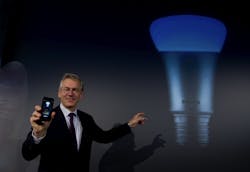Most tech companies are experimenting with new products for smart homes, giving everything from thermostats to light bulbs the ability to share information, like the machines in an automated assembly line. But there are problems lurking beneath home automation. Without a simple way for these devices to communicate, smart homes might have trouble being very smart.
That is the idea behind the Allseen Alliance, an organization that maintains open-source software for devices within the Internet of Things (IoT). The software is designed to get devices talking with each other regardless of operating system, wireless technology, or platform. It breaks down the barriers between private clouds, allowing products from different brands to work together.
The software is built around AllJoyn, one of several major frameworks vying to become the de facto standard for everything from smart homes to city infrastructure. Despite calls to consolidate around a single framework, AllJoyn competes with the Open Interconnect Consortium led by Intel, Cisco, Samsung, and General Electric. Other competitors include Google’s Weave protocol for its Brillo operating systems and Apple’s Homekit, which allows iPhone users to control smart home devices via Siri.
At the same time, the Allseen Alliance has signed agreements with other industry groups that have IoT frameworks in place. It recently partnered with the Personal Connected Health Alliance (PCHA), which focuses on interoperable connected health devices. The Allseen Alliance also says that it has strong ties with the EnOcean Alliance, which maintains a framework for smart buildings, and the Ultra Low Energy (ULE) standard.
The AllJoyn standard was originally developed at Qualcomm as a framework to connect smartphones and tablets, making it easier for developers to build new applications. The project quickly extended into IoT devices. In 2013, Qualcomm signed the framework over to the Linux Foundation, which now maintains the Allseen Alliance.
These days, AllJoyn software runs on most major operating systems, including Linux, Android, Arduino, iOS, and Windows. Like other competing standards, AllJoyn helps developers to make applications and hubs for controlling all kinds of gadgets. Manufacturers can use the framework to ensure interoperability across devices, systems, and services without the need for the cloud.
“It’s what HTTP and HTML did for the web,” said Rob Chandhok, the former president of Qualcomm’s Connected Experiences division (which built the original standard) in a 2013 interview. “It didn’t matter if you had Ethernet or Wi-Fi or what physical layers. Everyone could build for the web.”
The software handles the complexities of discovering nearby devices, bringing new devices onto local networks, creating sessions, sending notifications, and controlling devices from a central hub. In cases where developers want devices to access the cloud, they can connect through a “gateway agent” or central access point. The agent can also be used to connect devices working on different wireless protocols, such as Zigbee, Wi-Fi, Bluetooth, and Z-Wave.
The Allseen Alliance backs its software with a membership that intersects with other IoT standards groups. It includes LG Electronics, Panasonic, Qualcomm, Sharp, Cisco, Honeywell, IBM, Philips, Haier, and Microsoft. Several of these companies were among the first to have products certified by the Allseen Alliance last fall.
The certification program is still in its infancy but underlines some of the products that are using the standard. LG certified one of its smart televisions, while Microsoft did the same with its latest Surface Pro 3 tablet and Windows 10 Professional operating system. Smart lighting from LIFX, smart speakers from Gramofon, Heaven Fresh air purifiers, and control systems from Higgins are also certified.
Of course, most of these devices are designed for smart homes, but dominating that market could lead to new applications in smart cities and industrial sensor networks. And that is true not only for AllJoyn, but also for its competitors.
“Interoperability will drive scalability, and ultimately the growth of the entire ecosystem,” said Kira Allgood, Qualcomm Technologies’ vice president of global marketing development for smart cities, at the 2015 Allseen Alliance Summit.
About the Author
James Morra
Senior Editor
James Morra is the senior editor for Electronic Design, covering the semiconductor industry and new technology trends, with a focus on power electronics and power management. He also reports on the business behind electrical engineering, including the electronics supply chain. He joined Electronic Design in 2015 and is based in Chicago, Illinois.

